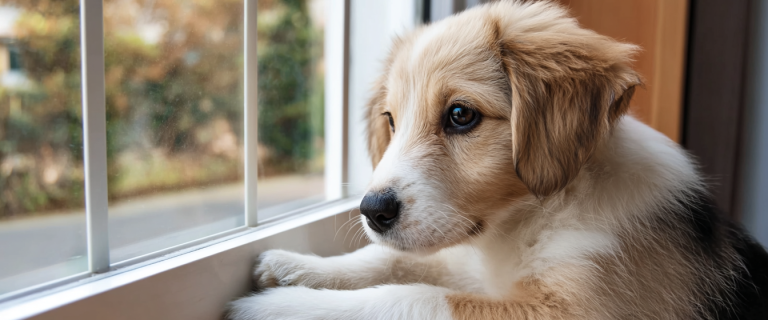Curious about litter box training for dogs and wondering whether it’s even something that would work for your pup? I was, too! It’s why I decided to thoroughly research if litter box training is a good idea and how it’s done. So please read on; you’ll soon have everything needed to decide whether it’s right for your pup.

Litter Box Training for Dogs: Will it Work for YOUR Pup?
The first thing to understand about litter box training for dogs is it’s not for everyone. Some dogs/owners just won’t find success with it or are incapable of doing it, period. However, there are a few scenarios where this training would be perfect.
I’ll discuss a few to see whether you fall into one of these categories. It’ll then become clear if litter box training is something to explore with your dog. So without further ado, here’s a look at several compatible circumstances:
1. Living in Upper-level Apartments
Dog owners in high-rise apartments will try anything to minimize the number of walks per day. Honestly, I don’t blame them, especially if they don’t have access to an elevator. I can’t imagine walking down/up 15+ stairs with my dog three to four times per day.
So litter box training becomes a valuable tool to minimize these trips. It gives your pup a place inside your home to go potty without consequences. Plus, you won’t be exhausted from traveling up those stairs several times a day.
2. Owners Suffering From Mobility Issues
Some people aren’t up to walking their dogs multiple times a day. For example, they may be suffering from a condition or illness that makes movement more difficult than it was previously. It creates an issue of how their dogs will get outside when necessary.
So they turn to other means of ensuring their dogs can relieve themselves. Placing a litter box inside and training them to use it can help make it easier for these owners. It certainly has been effective for my grandparents and their English Bulldog.
3. Dogs With a Lack of Bladder Control
Some canines won’t have the level of bladder control others do. In particular, smaller breeds with tiny bladders often struggle to hold their bathroom business over long stretches. It’s why many vets recommend litter box training for these breeds.
The same goes for puppies who are inexperienced with house training. In these cases, a litter box is a stop-gap option during their house training. It’ll help limit accidents while aiding them to understand there are proper and improper places to do their business.
For instance, I found success using a litter box when I was first housebreaking my parent’s Chihuahua. She took to the litter box immediately, making the process of making her completely house-broken much easier. Now, she uses both to ensure an accident-free lifestyle.
4. Lousy Weather Conditions
Raise your hand if you’ve woken up on a winter day where going outside for a dog walk was an almost impossible experience. If your hand is up, I’m betting that having an indoor litter box for your dog sounds like an excellent idea.
These litter box areas would help you avoid going out into those horrid conditions several times a day. You’ll no longer have to feel those awful cold gusts of wind on your face. Plus, I’m willing to imagine your dog won’t complain much about it, especially if they’re short-haired.
5. Older Dogs or Dogs Suffering From an Illness/Injury
Our last situation isn’t one any dog owner wants to experience. But a pup suffering from a specific illness or injury won’t enjoy going outside. So you can make it easier on them by teaching them to relieve themselves in a litter box.
Some owners with older dogs adopt this method, as well. It works well with dogs that aren’t as mobile as they once were. A vet may even recommend it if your dog’s movement has become severely limited or is suffering from arthritis.
What Type of Dogs Mesh Well with Litter Box Training?
As I mentioned earlier, litter box training is only for some dogs. Below is a short list of compatible breeds for context. They’re far from the ONLY dog breeds that can learn to use a litter box, but they’ll give you a good overview.
With the exception of #5, the bottom line is most of these suitable breeds will be on the smaller side (under 40 pounds) for obvious reasons:
- Chihuahua
- English Bulldog
- Cockapoo
- Maltese
- Border Collie (obviously, they’ll need a larger litter box)
- Bichon Frise
- Shiba Inu
- Miniature Schnauzer
- Pug
- Yorkshire Terrier
- Japanese Chin
- Shih Tzu
All of these breeds have a reputation for using litter boxes effectively. However, if you need more clarification about your dog’s compatibility, I’d recommend consulting with a vet. It’s a simple way to ensure a litter box is ideal for your specific situation.
How to Train Your Dog to Use a Litter Box
Since I’ve outlined situations where litter boxes could be helpful, it’s time to discuss the actual training process. So anyone who thinks this technique would be worthwhile should follow these next few steps to do it properly:

Step 1: Find a Spot to Place Your Dog’s Litter Box
Locating the perfect place for a doggy litter box can be tricky. After all, you must find a balance between hiding it away from guests and being accessible to your dog. Unfortunately, this combination only leaves a few potential options.
I recommend a guest bathroom or closed-off outside areas like a porch or patio. Both options would keep it away from everyone else while providing a comfortable space for your dog to do its business.
Step 2: Show Your Dog Their New Bathroom Spot
Once you’ve chosen a spot, it’s time to show your dog their new bathroom location. But it’s not simply about showing them the site: you must indicate that it’s meant for their bathroom business.
As you can imagine, this next part will be gross. It starts by grabbing a paper towel and collecting a little bit of your dog’s urine. You can then place this paper towel on the location to indicate its new bathroom spot.
You’ll need to repeat this gross process until your dog understands what it means. Thankfully, it shouldn’t take much time for them to grasp it. But some dogs require more patience than others, so hopefully, yours is a quick learner.
Step 3: Use Positive Reinforcement
No dog training technique works quite like positive reinforcement. So the next step is finding your dog’s favorite treat and using it as a reward. In other words, give your dog one every single time they use their new bathroom spot.
After a while, your dog will soon understand using this spot is good behavior. It’s just a matter of remaining consistent with the treats and offering them a little time. You also must refrain from getting discouraged by a little accident or two. If you keep up with the process, your dog will eventually start getting it.
Step 4: Clean The Litter Box
Litter boxes require some upkeep because they get dirty quickly. Due to this, owners will have to clean them out regularly to ensure their dogs continue using them. Otherwise, he may turn his nose away from it and have an accident elsewhere.
If you need help cleaning the litter box, I recommend looking at the instructions. Most litter boxes will have detailed directions about how to clean them effectively. Please stay away from using bleach or other heavy-duty cleaners.

Step 5: Enjoy Your Accident-Free Home
The last step to litter box training for dogs is to enjoy your bathroom accident-free home! You’ll no longer have to worry about turning a corner in your home and stepping in a pee puddle. Instead, your dog will know exactly where to go when nature calls!
Our List of Recommended Litter Boxes For Dogs
If you need more clarification about what litter box to buy, here’s a list of my favorites. Each one has a stellar reputation for usability with dogs. Plus, it’ll provide some context into what you should be looking for in these products.
FYI, this section includes affiliate links. If you buy anything through them, DogVills earns a small commission at no extra cost to you.
If you need help choosing a good litter, here are a few options that I like:
- BoxiePro Deep Clean Probiotic Clumping Litter
- Petco Brand – So Phresh Dog Litter with Odor Control Paper (Non-Clumping)
- Naturally Fresh Cat Litter – Walnut-Based Quick-Clumping Kitty Litter
In Closing,
Litter box training is only effective with certain dogs, specifically smaller ones. But with compatible pups, it can be a godsend for owners. Especially those who just can’t walk their dogs as often as they’d like.
If you have any more questions about litter box training for dogs, please use our comment section below. I’d also love to hear about your experience with it if you’ve tried it. Thanks for reading!
Author
-

My name is Ben Roberts, and I’ve been writing about animals for many years. Honestly, I couldn’t ask for a much better job, considering I’ve been around animals all my life. I can’t remember a time when there wasn’t at least one cat or dog inside my home. Currently, I’m a proud owner of a Beagle and a Pitbull who make sure my life is never dull.
View all posts




